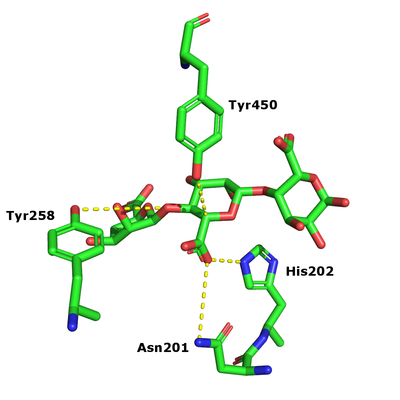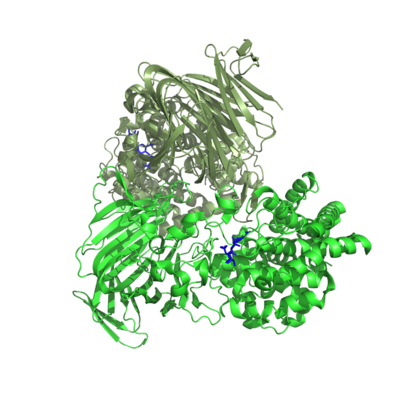CAZypedia needs your help! We have many unassigned GH, PL, CE, AA, GT, and CBM pages in need of Authors and Responsible Curators.
Scientists at all career stages, including students, are welcome to contribute to CAZypedia. Read more here, and in the 10th anniversary article in Glycobiology.
New to the CAZy classification? Read this first.
*
Consider attending the 15th Carbohydrate Bioengineering Meeting in Ghent, 5-8 May 2024.
Difference between revisions of "Polysaccharide Lyase Family 17"
Emil Stender (talk | contribs) |
Harry Brumer (talk | contribs) m (Text replacement - "\^\^\^(.*)\^\^\^" to "$1") |
||
| (18 intermediate revisions by 3 users not shown) | |||
| Line 1: | Line 1: | ||
<!-- RESPONSIBLE CURATORS: Please replace the {{UnderConstruction}} tag below with {{CuratorApproved}} when the page is ready for wider public consumption --> | <!-- RESPONSIBLE CURATORS: Please replace the {{UnderConstruction}} tag below with {{CuratorApproved}} when the page is ready for wider public consumption --> | ||
| − | {{ | + | {{CuratorApproved}} |
| − | * [[Author]]: | + | * [[Author]]: [[User:Emil Stender|Emil Stender]] |
| − | * [[Responsible Curator]]: | + | * [[Responsible Curator]]: [[User:Birte Svensson|Birte Svensson]] |
---- | ---- | ||
| Line 13: | Line 13: | ||
|- | |- | ||
|'''3D structure''' | |'''3D structure''' | ||
| − | |(α/α)6 barrel + anti-parallel β-sheet | + | |(α/α)<sub>6</sub> barrel + anti-parallel β-sheet |
|- | |- | ||
|'''Mechanism''' | |'''Mechanism''' | ||
| − | |β- | + | |β-elimination |
|-|- | |-|- | ||
|'''Charge neutralizer''' | |'''Charge neutralizer''' | ||
| Line 33: | Line 33: | ||
== Substrate specificities == | == Substrate specificities == | ||
| − | PL17 | + | PL17 contains 2 subfamilies <cite>Lombard2010</cite> as well as several proteins currently not assigned to any subfamily. Subfamily 2 has been shown to be exolytic alginate lyases <cite>Jagtap2014,Park2014,Shin2015,Wang2015</cite> with activity for all three block structures observed <cite>Mathieu2018</cite>. Alginate consisting of 1,4 linked β-{{Smallcaps|D}}-mannuronic acid and α-{{Smallcaps|L}}-guluronic acid arranged in poly-mannuronic acid , poly-guluronic acid or poly-mannuronic/guluronic acid blocks <cite>Haug1967,Haug1966</cite>. Subfamily 1 has been found to be hyaluroran endo-lyases or poly-glucuronic acid lyases <cite>Mathieu2018</cite>. Hyaluronan consisting of ''N''-acetyl-{{Smallcaps|D}}-glucoamine and 1,4 linked {{Smallcaps|D}}-glucoronic acid <cite>Meyer1940</cite>. |
== Kinetics and Mechanism == | == Kinetics and Mechanism == | ||
| − | + | [[Image:Cat_res_PL17.png|thumb|400px|'''Figure 1.''' +1 subsite of the alginate lyase Alg17c (PDB: 4OJZ)]] | |
| + | The β-elimination catalyzed by the PL17 enzymes results in the formation of a C4-C5 unsaturated sugar at the new non-reducing end. The first step is the neutralization of the acid group in the +1 subsite by the conserved histidine and asparagine. This lowers the pKa value of the C5-proton allowing for abstraction by the catalytic base (Figure 1). A catalytic acid then donates a proton to the glycosidic linkage resulting in the β-elimination <cite>Park2014</cite>. | ||
== Catalytic Residues == | == Catalytic Residues == | ||
| − | + | After charge neutralization a tyrosine functions as the catalytic base and another tyrosine as the acid. These were originally identified as Y456 and Y258 in Alg17c from ''Saccharophagus degradans'' <cite>Park2014</cite>. | |
== Three-dimensional structures == | == Three-dimensional structures == | ||
| − | + | [[Image:PL17_structure.png|thumb|400px|'''Figure 2.''' Crystal structures of the substrate complex of the homo-dimeric Alg17c (PDB: 4OJZ) with the substrate in blue.]] | |
| + | One crystal structure is available in PL17, that of Alg17c from Saccharophagus degradans belonging to subfamily 2 <cite>Park2014</cite>. It is an (α/α)6 barrel + anti-parallel β-sheet with the catalytic machinery located in the (α/α)<sub>6</sub> barrel (Figure 2). Alg17c is a homodimer, though that does not appear to be a general feature of PL17 <cite>Jagtap2014,Park2014,Shin2015,Wang2015</cite>. | ||
== Family Firsts == | == Family Firsts == | ||
| − | ;First | + | ;First catalytic activity: MJ-3 alginate lyase assayed by monitoring the absorbance at 235 nm and characterizing the degradation products by TLC and <sup>1</sup>H-NMR <cite>Park2012</cite>. |
| − | ;First catalytic | + | ;First catalytic base/acid: Y456 and Y258 in Alg17c crystal structure identified by their conservation in PL17, mutagenesis and kinetic analysis of mutants (Y258A and Y450A inactive) <cite>Park2014</cite> |
| − | ;First | + | ;First charge neutralizer: N201 and H202 in the Alg17c crystal structure identified by their conservation in PL17, mutagenesis and kinetic analysis (N201A inactive and H202L 4.6 % activity remaining) <cite>Park2014</cite> |
| − | ;First 3-D structure: | + | ;First 3-D structure: Alg17c crystal structure <cite>Park2014</cite> |
| − | |||
== References == | == References == | ||
<biblio> | <biblio> | ||
| Line 55: | Line 56: | ||
#Jagtap2014 pmid=24795372 | #Jagtap2014 pmid=24795372 | ||
#Park2014 pmid=24478312 | #Park2014 pmid=24478312 | ||
| − | #Shin2015 Shin, J. W., Lee, O. K., Park, H. H., Kim, H. S., and Lee, E. Y. (2015) Molecular characterization of a novel oligoalginate lyase consisting of AlgL- and heparinase II/III-like domains from Stenotrophomonas maltophilia KJ-2 and its application to alginate saccharification. Korean J. Chem. Eng. 32, 917–924 | + | #Shin2015 Shin, J. W., Lee, O. K., Park, H. H., Kim, H. S., and Lee, E. Y. (2015) Molecular characterization of a novel oligoalginate lyase consisting of AlgL- and heparinase II/III-like domains from Stenotrophomonas maltophilia KJ-2 and its application to alginate saccharification. Korean J. Chem. Eng. 32, 917–924 [http://dx.doi.org/10.1007/s11814-014-0282-1 DOI:10.1007/s11814-014-0282-1] |
#Wang2015 pmid=25335746 | #Wang2015 pmid=25335746 | ||
#Mathieu2018 pmid=29795267 | #Mathieu2018 pmid=29795267 | ||
| − | #Haug1967 Haug, A., Larsen, B., and Smidsrod, O. (1967) Studies on sequence of uronic acid residues in alginic acid. Acta Chem. Scand. 21, 691–704 | + | #Haug1967 Haug, A., Larsen, B., and Smidsrod, O. (1967) Studies on sequence of uronic acid residues in alginic acid. Acta Chem. Scand. 21, 691–704 [http://dx.doi.org/10.3891/acta.chem.scand.21-0691 DOI:10.3891/acta.chem.scand.21-0691] |
| − | #Haug1966 Haug, A., Larsen, B., and Smidsrod, O. (1966) A study of constitution of alginic acid by partial acid hydrolysis. Acta Chem. Scand. 20, 183–190 | + | #Haug1966 Haug, A., Larsen, B., and Smidsrod, O. (1966) A study of constitution of alginic acid by partial acid hydrolysis. Acta Chem. Scand. 20, 183–190 [http://dx.doi.org/10.3891/acta.chem.scand.20-0183 DOI:10.3891/acta.chem.scand.20-0183] |
| + | #Meyer1940 pmid=19870951 | ||
| + | #Park2012 pmid=21826589 | ||
</biblio> | </biblio> | ||
[[Category:Polysaccharide Lyase Families|PL017]] | [[Category:Polysaccharide Lyase Families|PL017]] | ||
Latest revision as of 14:14, 18 December 2021
This page has been approved by the Responsible Curator as essentially complete. CAZypedia is a living document, so further improvement of this page is still possible. If you would like to suggest an addition or correction, please contact the page's Responsible Curator directly by e-mail.
| Polysaccharide Lyase Family 17 | |
| 3D structure | (α/α)6 barrel + anti-parallel β-sheet |
| Mechanism | β-elimination |
| Charge neutralizer | Asparagine and histidine |
| Active site residues | known |
| CAZy DB link | |
| http://www.cazy.org/PL17.html | |
Substrate specificities
PL17 contains 2 subfamilies [1] as well as several proteins currently not assigned to any subfamily. Subfamily 2 has been shown to be exolytic alginate lyases [2, 3, 4, 5] with activity for all three block structures observed [6]. Alginate consisting of 1,4 linked β-D-mannuronic acid and α-L-guluronic acid arranged in poly-mannuronic acid , poly-guluronic acid or poly-mannuronic/guluronic acid blocks [7, 8]. Subfamily 1 has been found to be hyaluroran endo-lyases or poly-glucuronic acid lyases [6]. Hyaluronan consisting of N-acetyl-D-glucoamine and 1,4 linked D-glucoronic acid [9].
Kinetics and Mechanism
The β-elimination catalyzed by the PL17 enzymes results in the formation of a C4-C5 unsaturated sugar at the new non-reducing end. The first step is the neutralization of the acid group in the +1 subsite by the conserved histidine and asparagine. This lowers the pKa value of the C5-proton allowing for abstraction by the catalytic base (Figure 1). A catalytic acid then donates a proton to the glycosidic linkage resulting in the β-elimination [3].
Catalytic Residues
After charge neutralization a tyrosine functions as the catalytic base and another tyrosine as the acid. These were originally identified as Y456 and Y258 in Alg17c from Saccharophagus degradans [3].
Three-dimensional structures
One crystal structure is available in PL17, that of Alg17c from Saccharophagus degradans belonging to subfamily 2 [3]. It is an (α/α)6 barrel + anti-parallel β-sheet with the catalytic machinery located in the (α/α)6 barrel (Figure 2). Alg17c is a homodimer, though that does not appear to be a general feature of PL17 [2, 3, 4, 5].
Family Firsts
- First catalytic activity
- MJ-3 alginate lyase assayed by monitoring the absorbance at 235 nm and characterizing the degradation products by TLC and 1H-NMR [10].
- First catalytic base/acid
- Y456 and Y258 in Alg17c crystal structure identified by their conservation in PL17, mutagenesis and kinetic analysis of mutants (Y258A and Y450A inactive) [3]
- First charge neutralizer
- N201 and H202 in the Alg17c crystal structure identified by their conservation in PL17, mutagenesis and kinetic analysis (N201A inactive and H202L 4.6 % activity remaining) [3]
- First 3-D structure
- Alg17c crystal structure [3]
References
- Lombard V, Bernard T, Rancurel C, Brumer H, Coutinho PM, and Henrissat B. (2010). A hierarchical classification of polysaccharide lyases for glycogenomics. Biochem J. 2010;432(3):437-44. DOI:10.1042/BJ20101185 |
- Jagtap SS, Hehemann JH, Polz MF, Lee JK, and Zhao H. (2014). Comparative biochemical characterization of three exolytic oligoalginate lyases from Vibrio splendidus reveals complementary substrate scope, temperature, and pH adaptations. Appl Environ Microbiol. 2014;80(14):4207-14. DOI:10.1128/AEM.01285-14 |
- Park D, Jagtap S, and Nair SK. (2014). Structure of a PL17 family alginate lyase demonstrates functional similarities among exotype depolymerases. J Biol Chem. 2014;289(12):8645-55. DOI:10.1074/jbc.M113.531111 |
-
Shin, J. W., Lee, O. K., Park, H. H., Kim, H. S., and Lee, E. Y. (2015) Molecular characterization of a novel oligoalginate lyase consisting of AlgL- and heparinase II/III-like domains from Stenotrophomonas maltophilia KJ-2 and its application to alginate saccharification. Korean J. Chem. Eng. 32, 917–924 DOI:10.1007/s11814-014-0282-1
- Wang L, Li S, Yu W, and Gong Q. (2015). Cloning, overexpression and characterization of a new oligoalginate lyase from a marine bacterium, Shewanella sp. Biotechnol Lett. 2015;37(3):665-71. DOI:10.1007/s10529-014-1706-z |
- Mathieu S, Touvrey-Loiodice M, Poulet L, Drouillard S, Vincentelli R, Henrissat B, Skjåk-Bræk G, and Helbert W. (2018). Ancient acquisition of "alginate utilization loci" by human gut microbiota. Sci Rep. 2018;8(1):8075. DOI:10.1038/s41598-018-26104-1 |
-
Haug, A., Larsen, B., and Smidsrod, O. (1967) Studies on sequence of uronic acid residues in alginic acid. Acta Chem. Scand. 21, 691–704 DOI:10.3891/acta.chem.scand.21-0691
-
Haug, A., Larsen, B., and Smidsrod, O. (1966) A study of constitution of alginic acid by partial acid hydrolysis. Acta Chem. Scand. 20, 183–190 DOI:10.3891/acta.chem.scand.20-0183
- Meyer K, Hobby GL, Chaffee E, and Dawson MH. (1940). THE HYDROLYSIS OF HYALURONIC ACID BY BACTERIAL ENZYMES. J Exp Med. 1940;71(2):137-46. DOI:10.1084/jem.71.2.137 |
- Park HH, Kam N, Lee EY, and Kim HS. (2012). Cloning and characterization of a novel oligoalginate lyase from a newly isolated bacterium Sphingomonas sp. MJ-3. Mar Biotechnol (NY). 2012;14(2):189-202. DOI:10.1007/s10126-011-9402-7 |

